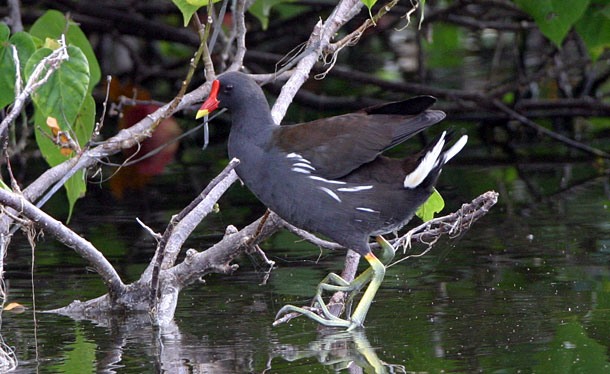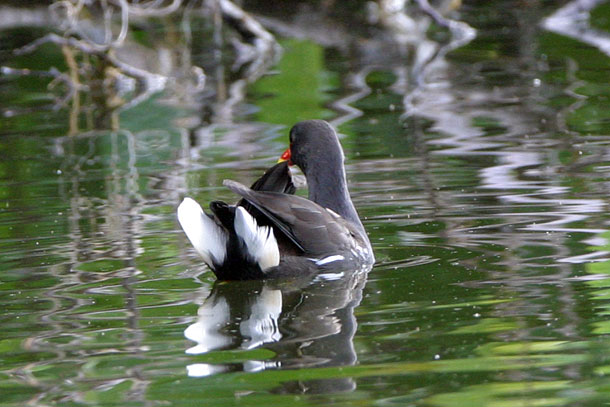COMMON MOORHEN; EXCLUSIVE BIRD TO FUVAHMULAK IN THE MALDIVES
Common Moorhen (Gallinula chloropus) is a freshwater bird locally known as Valikukulhu or Olhuvalu Kanbili , a duck-like bird in the Rallidae family is found almost exclusively within fresh water wetlands around well-vegetated marshes and ponds in Fuvahmulak. Common Moorhen is basically confined to Fuvahmulak, the atoll island inhabited in the South nearest to the equator in the Maldives. Elsewhere in the world, the Common Moorhen is commonly found rail species. Common Moorhen has a yellow tipped red bill; their legs are greenish and unwebbed feet, with orange or red bands on the lower part. Adults have white stripes on the flanks and have a white rump divided by a black band. Croaks and squawks make up their voice.

Common Moorhen is basically confined to Fuvahmulak. Photo: Mohamed Kaisan
FOOD AND FEEDING
Common Moorhen primarily feeds on worms, vegetable matter, snail, small fish and aquatic insects.
NESTING AND COURTSHIP
Common Moorhen both male and female birds help to build the nest of floating vegetation. Nests of the Moorhen are built on the water or very close by. The male carries the materials and the female arranges them. Nests are also stages for courtship, and it is ritualized and courtship chasing also associated with pair formation.
The Common Moorhen usually lay from five to eleven eggs that are greenish white with spots. However some study shows that the Common Moorhen lays three to four eggs in the tropics. Though no research has been done local people assume that Common Moorhen in Faumulak lays three eggs. In a Common Moorhen nest, more than three eggs can be seen, but sometime wetland bird White-breasted Waterhen (Amaurornis phoenicurus) locally know as Kanbli also lays eggs in the nest of Common Moorhen. It takes between 20 to 21 days for the eggs to hatch. The young take 32 days or two months to fledge.
The Common Moorhen nest has a wide shallow cup in the center for the eggs, may be partly floating. Adults eat the eggshells after the chicks hatch. They feed the chicks soon after hatching, mostly insects and their larvae.

Moorhens are incredibly intelligent – this Moorhen has built its nest on the water with polythene like cover of a Magnum Ice Cream, most probably to stop water soaking the nest.
Immature birds have white necks with a white streak on the side and they have brownish coloured body. They bird have brownish legs.
HABITAT
It is widely believed that the freshwater wetland around well-vegetated marshes in Fuvahmulak has led to the successful flourishing of Common Moorhen for more than a century.
CONSERVATION AND ECONOMIC IMPORTANCE
Common Moorhen is a protected bird in the Maldives; hence, their capture, sale and captivity have been prohibited. However, there are no vital conservation measures taken to protect the nesting habitats of Common Moorhen. In order to flourish the Common Moorhen, the exclusive bird of Fuvahmulak, it is vital to protect the habitat of this beautiful and interesting bird and control pests such as rats and cats.

Common Moorhen are very good swimmers.   Photo: Mohamed Kaisan
References:
Ash, J.S. and Shafeeg, Ali (1994) Birds of the Maldive Islands, Indian Ocean, Forktail 10; 3-34.
Nasuruhlo Ali (1997) “ A Faumulak†Valukukulhu†Madhuvaan Sababu Hoadhanjehifaa†Dhanffulhi
Rasheed, K. (1999) Maldives protected 22 species of birds. Haveeru (Daily newspaper in Dhivehi).
